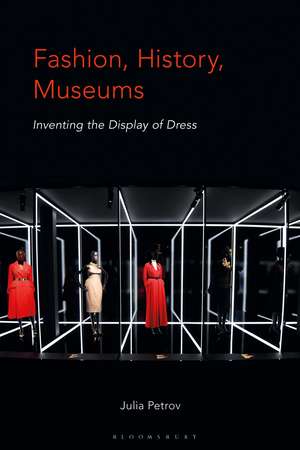Fashion, History, Museums: Inventing the Display of Dress
Autor Julia Petroven Limba Engleză Paperback – 24 feb 2021
Preț: 199.56 lei
Preț vechi: 231.22 lei
-14% Nou
Puncte Express: 299
Preț estimativ în valută:
38.19€ • 39.53$ • 32.28£
38.19€ • 39.53$ • 32.28£
Carte disponibilă
Livrare economică 12-26 februarie
Livrare express 29 ianuarie-04 februarie pentru 60.58 lei
Preluare comenzi: 021 569.72.76
Specificații
ISBN-13: 9781350229662
ISBN-10: 1350229660
Pagini: 248
Ilustrații: 8 color and 61 bw illus
Dimensiuni: 156 x 234 x 19 mm
Greutate: 0.43 kg
Editura: Bloomsbury Publishing
Colecția Bloomsbury Visual Arts
Locul publicării:London, United Kingdom
ISBN-10: 1350229660
Pagini: 248
Ilustrații: 8 color and 61 bw illus
Dimensiuni: 156 x 234 x 19 mm
Greutate: 0.43 kg
Editura: Bloomsbury Publishing
Colecția Bloomsbury Visual Arts
Locul publicării:London, United Kingdom
Caracteristici
Critically analyses trends in fashion exhibition practice, in thematically organised chapters which compare and contrast exhibitions from different museums and decades.
Notă biografică
Julia Petrov is Curator of Western Canadian History at the Royal Alberta Museum, Canada.
Cuprins
List of IllustrationsAcknowledgementsIntroduction: Fashion as Museum Object1. Foundation Garments: Precedents for Fashion History Exhibitions in Museums2. Window Shopping: Commercial Inspiration for Fashion in the Museum3. The New Objectivity: Social Science Methods for the Display of Dress4. Intervisuality: Displaying Fashion as Art5. Tableaux Vivants: The Influence of Theatre6. The Body in the Gallery: Revivifying Historical Fashion7. The Way of All Flesh: Displaying the Historicity of Historical Fashion8. The New Look: Contemporary Trends in Fashion ExhibitionsNotesBibliographyIndex
Recenzii
The book serves as a valuable entry into the continually evolving field of fashion curation and would make a worthwhile purchase for any library with programs in art history, museum studies, fashion studies, or design history.
[Contains] rich illustrations ... Moreover, with 20 pages of references, the book confirms itself as a precious source in the study of the subject. Perhaps more interestingly, it is possible that this publication will become the ever-present reference in future books ... Petrov's work is inspiring for scholars not just for the contents but even for her disciplined writing. The quoted exhibitions are, without a doubt, the greatest strength in this study.
A remarkable resource for the field of fashion studies suitable for both newcomers who will appreciate the abundance of history and references, as well as seasoned practitioners that may see their own work in a different light ... One of the most striking aspects of this book [is] that the issues that seem to plague every fashion exhibition, from mannequin heads and wigs to gaps in the collection, have been with us from the start. Perhaps with the addition of this book, we can collectively start to sort out solutions.
Comprehensive, well-argued and original, this book includes invaluable insights from a practicing curator and historian, and places the museum exhibition in the larger discourse of fashion and its history.
Petrov's sharp and critical insights put the current worldwide rise of fashion exhibitions in an historic continuum, raising questions that should be on the mind of every fashion curator or museum working with fashion. By far the most thought provoking book on fashion curation of the past years.
This is a valuable addition to the scholarship dedicated to the complex relationship between fashion and museums. Petrov retraces connections and highlights pivotal experiences, providing a thorough study - useful not only to consider history, but also to reflect on future practices.
This is an insightful addition to the growing field of fashion curating. Stretching over the last century and beyond, Petrov's contribution is an original analysis of the museum as a site where fashion, commerce, art and history intertwine. [A] must-read for students of fashion and anyone interested in the field.
A welcome account of the key historical developments in establishing the display of dress and, in turn, the culture of fashion exhibitions; a useful contribution to fashion studies.
[Contains] rich illustrations ... Moreover, with 20 pages of references, the book confirms itself as a precious source in the study of the subject. Perhaps more interestingly, it is possible that this publication will become the ever-present reference in future books ... Petrov's work is inspiring for scholars not just for the contents but even for her disciplined writing. The quoted exhibitions are, without a doubt, the greatest strength in this study.
A remarkable resource for the field of fashion studies suitable for both newcomers who will appreciate the abundance of history and references, as well as seasoned practitioners that may see their own work in a different light ... One of the most striking aspects of this book [is] that the issues that seem to plague every fashion exhibition, from mannequin heads and wigs to gaps in the collection, have been with us from the start. Perhaps with the addition of this book, we can collectively start to sort out solutions.
Comprehensive, well-argued and original, this book includes invaluable insights from a practicing curator and historian, and places the museum exhibition in the larger discourse of fashion and its history.
Petrov's sharp and critical insights put the current worldwide rise of fashion exhibitions in an historic continuum, raising questions that should be on the mind of every fashion curator or museum working with fashion. By far the most thought provoking book on fashion curation of the past years.
This is a valuable addition to the scholarship dedicated to the complex relationship between fashion and museums. Petrov retraces connections and highlights pivotal experiences, providing a thorough study - useful not only to consider history, but also to reflect on future practices.
This is an insightful addition to the growing field of fashion curating. Stretching over the last century and beyond, Petrov's contribution is an original analysis of the museum as a site where fashion, commerce, art and history intertwine. [A] must-read for students of fashion and anyone interested in the field.
A welcome account of the key historical developments in establishing the display of dress and, in turn, the culture of fashion exhibitions; a useful contribution to fashion studies.
